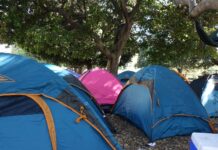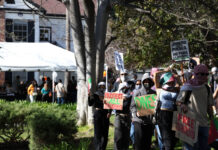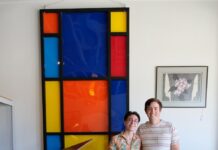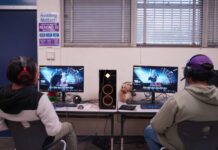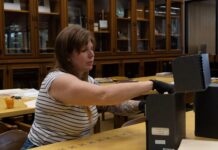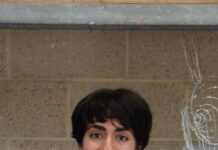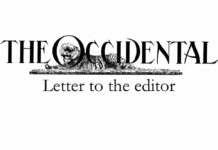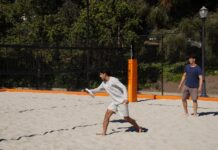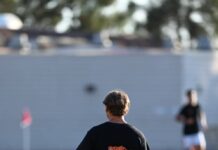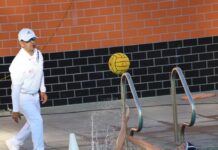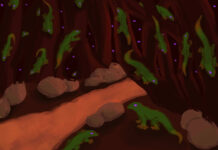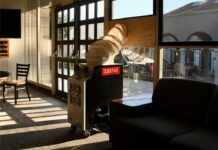Author: Ryan Strong & Michelle Park
Three Stewart-Cleland (Stewie) residents were recently found responsible of violating the College Damages Policy and Residential Education and Housing Services’ (REHS) Damages Policy based on Facebook photos depicting the students with stacked furniture. They were given a six-month censure, fined 259 dollars and required to take an online course. The Occidental Weekly examined the disciplinary records, evidence and policy surrounding the allegations.
The students, however, claim that the furniture they stood on did not break and want to appeal the decision.
Two other students were included in the fines and discipline but have a slightly different situation. At least one of these students admitted to stacking furniture earlier in the year.
Students claim Conduct Officer and Graduate Hall Coordinator Mandla Gobledale ’09 was vague and the process misleading. Also, they were surprised to find that on their outcome letter, they had pled responsible to the College Damages Policy which states that they committed “attempted or actual damage to College Property.”
“It was very misleading because the whole time Jack [Stewie Resident Advisor] said it would be okay, and we each met with Mandla a couple weeks later and when we said we plead responsible, basically we took responsibility for taking pictures with stacked furniture not like, ‘Oh, I plead responsible for violating policy and damaging stuff.’ That never came out of my mouth and they put that on there and that’s really frustrating.” Marlena Lu (first-year) said.
Stewie has had a significant furniture-stacking issue this year, and the discipline relates to that issue. However, the students have maintained that they came across the furniture in the common room well after it was stacked and took photos that they later posted on Facebook. Gobledale’s outcome letter, which officially notifies students of discipline, does not indicate that he found otherwise.
In his letter to Lu, Gobledale summarizes what she took responsibility for.
“Marlena, in our meeting we talked about the proper use of college owned facilities, including the common room furniture and you said that you understood that you should not be misusing it and that you had stood on a sofa and taken the photos of other people on the stacked furniture,” he wrote.
The letter then stated that Lu pled responsible to violating the College Damages Policy. Lu disagrees with his conclusion.
Gobledale’s writes in his outcome letter explaining the finding, “Remember, that it is not your intentions, as much as the possible outcome of what you actually did, misusing the furniture, that is inappropriate.”
Here, Gobledale both acknowledges that the students did not attempt to damage any furniture, when he refers to their intentions, and also accepts that the students did not do “actual damage” to furniture.
Instead, he indicates that the problem was “the possible outcome of what you actually did.”
During the conduct conference, Gobledale also advanced the notion that although the furniture might not have been damaged, by standing on it the students may have caused extra stress that could cause it to break in the future, according to students. This explanation for why the students committed “attempted or actual damage” to “college property” is not contained in the outcome letter.
Gobledale was asked to comment on these issues but declined due to strict privacy laws.
The question Gobledale’s interpretations of policy raise relate to the definition of the words “attempted or actual damage” appearing in the handbook.
Associate Director of Accountability and Advocacy Emily Harris defined “actual damage” as “The damage that occurred.”
The students don’t understand how they could have known, based on the handbook’s words, that Gobledale’s interpretations of “actual damage” would be grounds for their 259 dollar fines and six month censures.
“I didn’t think that those actions would have such serious repercussions, especially since we were not responsible for stacking them or breaking the furniture,” Morgan Winston (first-year) said.
Gobledale levied 259 dollar fines for three chairs that students said are not in the Facebook photos. He never asserts that students damaged any furniture in his summary of inappropriate behavior.
During the conduct hearing, students say Gobledale presented a separate photo of the stacked chairs.
“The picture of the two stacked arm chairs that were included in our conduct hearings was completely irrelevant to our situation. We did not stack those chairs,” Lu said.
It is unclear whether the students were specifically found responsible for the stacking of the chairs that they emphatically deny doing or if the fines were just added as further discipline for standing on the couch and stacked table. Lu thinks its the latter.
Assistant Dean of Residential Education and Housing Services Tim Chang and Harris say, however, that the fines are only levied against specific students if a conduct officer finds that those students damaged the furniture.
On the plea issue, administrators explained that the plea is not important when it comes to the conduct officer’s actual finding. The plea, they say, directs the conversation and basically notates whether the students have taken responsibility for their actions or not. Sometimes, they say, an outcome letter will come back with a responsible plea but a non-responsible finding. The plea does not preclude the students from appealing.
“That does not have much bearing on the outcome,” Chang said. Harris said that, if a student disagreed with the plea, she would just change it on the outcome letter.
The students were also accused of violating a clause in the REHS Damages Policy not specifically cited in the paperwork. A relevant clause may be one that requires students to report damages they see to REHS staff promptly.
Like Gobledale, administrators could not answer questions on this specific case due to privacy laws. But they say all conduct outcomes decided by graduate hall coordinators are reviewed before being sent to students.
Stewie’s Issues
Although the furniture stacking issue has been the most persistent, Stewie has had many other issues such as a dead possum and tree branches in the hallway along with feces in the stairwell. However, the furniture stacking issue has been the biggest concern for RAs this year.
Administrators say the behavior is dangerous and detrimental to the community. They say that the furniture is not light, could injure students trying to un-stack the furniture in order to use the common room, and wastes staff time while putting them in harm’s way.
“They don’t get paid to get hurt,” Chang said.
But some students think RAs have not taken a good approach to resolving the issues in Stewie. They argue some RAs actively seek out violators to punish.
Chang describes RAs as community builders who also have a responsibility to keep the community safe and document violations.
He says that there are always a few students in a class who commit violations, and they happen to live in Stewie this year.
An RA, whom students identified as one of the most aggressive left Stewie earlier in the semester after students wrote a hateful message on her door.
Some students in Stewie have acknowledged that a few residents were and are out of control.
“In a single week there were two windows shattered, a fire extinguisher stolen and sprayed all over the bathroom floor, pee on the floor, and barf on the walls….As you can see, Stewie has experienced a lot of disrespect,” Stewie resident Abby Martin (first-year) said.
Martin went on to describe the furniture-stacking issue, including how the culprits posted signs on the walls pleading for the stacking they were doing to stop.
“The same students also started a facebook page for the S
tackmonster and friended the RAs. Overall, these students were just rubbing their disobedience and success in the RAs’ faces,” she said.
The culmination of trouble in Stewie seemed to be the prosecution of the five students for standing on the couch and stacked table. Sutorius (junior) submitted an incident report, based on photos he found on facebook.
“He built this false sense of security of friendship with us to the point where we can invite him to an off-campus party where he can drink with us, but suddenly he turns on that and writes us up for these things it’s such a switch it’s almost unfair and it’s very upsetting,” Lu said.
“I think that when an RA discovered pictures of students sitting on top of the stacked furniture on facebook, he overreacted at a chance to finally punish someone for the all of the damage done to Stewie,” Martin said.
Students say that Stewie’s new RA has helped ease tensions within the dorm, creating an environment that will get the residents through the last part of the year. They say the majority of RAs in Stewie have always created a good environment.
“It’s not all the RAs, though, and it would really suck for them if this event, which involved one RA and an MRA, reflected badly on them,” Laurel Cox (first-year) said.
Despite the easing of tensions, the debate regarding the use of Facebook in the conduct process continues.
Facebook Controversy
Administrators generally defended the use of Facebook in the conduct process. Chang lumps it in with all the other technologies out there.
“If a student is not going to be smart about Facebook, that’s their responsibility,” Chang said.
But, both Chang and Assistant Director of Residential Education Juls White stressed that they are not searching for questionable conduct.
“We are not looking for violators,” Chang said, explaining that RAs do not have time to use Facebook for investigations.
Some students disagree. One alleges Sutorius posted a comment on Facebook that contradicts the administrators.
“Later he goes: ‘on the weekend I tally resident’s Facebook photos that contain alcohol in it. I’ve made a portfolio for each one of them.’ That’s almost a joke except that’s how we all got caught.
Whether he actually tallied up all these Facebook photos or not, he actually peruses Facebook in search of things that incriminates students,” Julian Kauffman (first-year) said. He was one of the two students who had a slightly different situation.
“One of the things that they used as evidence in terms of my involvement in this is that I literally liked a status on the stackmonster page. They literally showed a picture of it to me. I literally liked this one status and they were like you liked this therefore you must be responsible,” Lu said.
“Jack in his incident report said I was responsible for the stack monster thing on Facebook because there were a couple friends of the profile who were uniquely mine which is ridiculous because I didn’t read the page” Julian Kauffman (first-year) said.
An email Sutorius sent to students informing them of a filed incident report stated his beliefs on Facebook.
“I would like to stress that putting up incriminating or implicating photos up on facebook, a public sharing site, is a foolish endeavor.”
White acknowledged that sometimes RAs can go overboard.
Are there RAs that are not very much liked? Sure. And are the reasons valid? Sure. But we have to understand that they too are students and they too are learning,” she said. “But, when you sit and listen to the RAs talk, they are genuinely caring people. They always want to help people see the values in difference, they embrace and celebrate diversity, and they especially strive to give back to the community”.
This article has been archived, for more requests please contact us via the support system.
![]()




